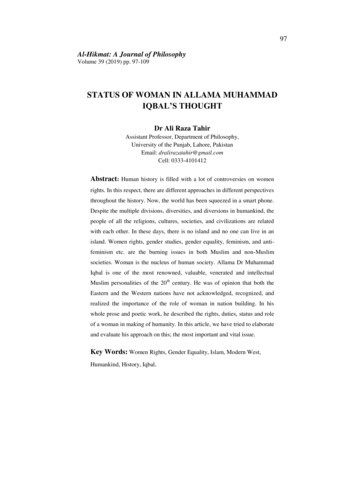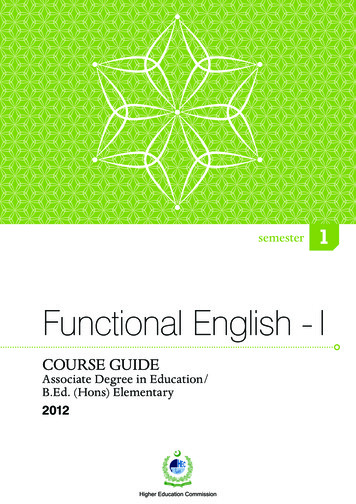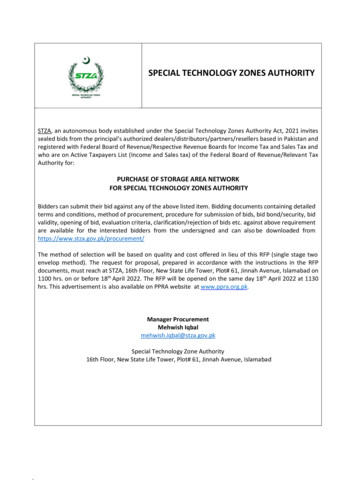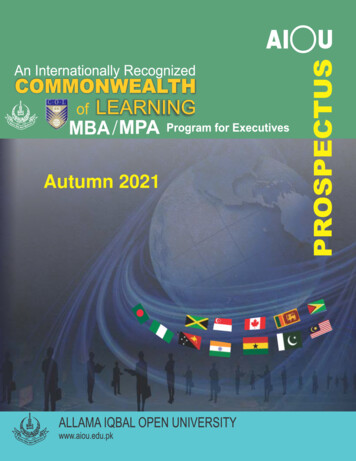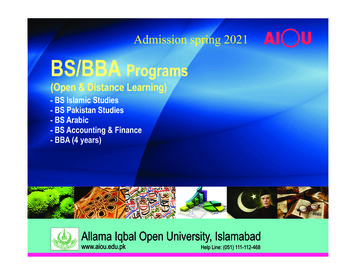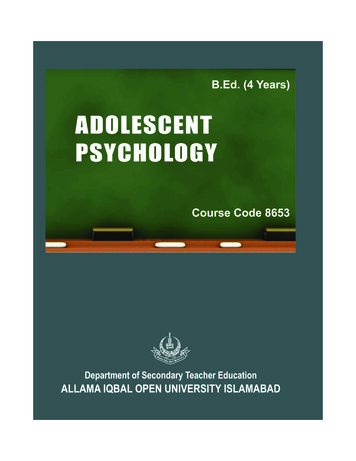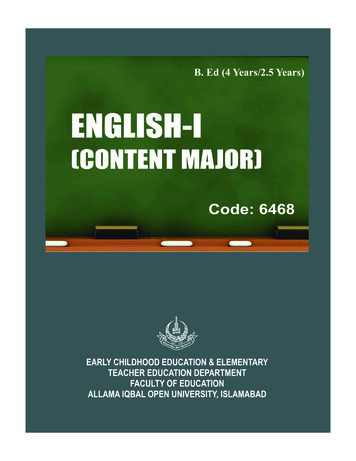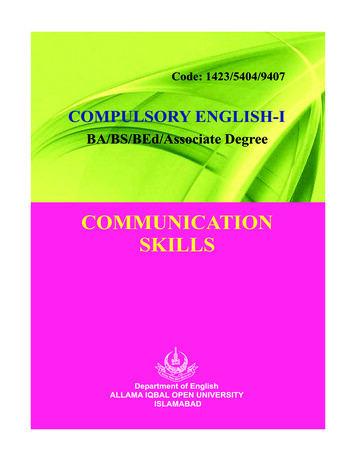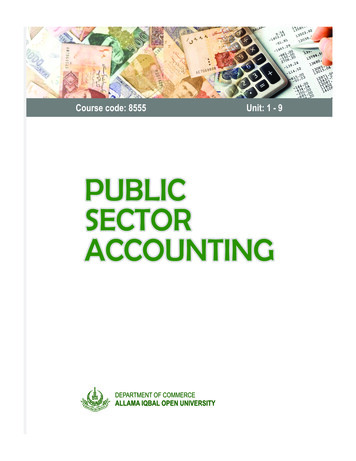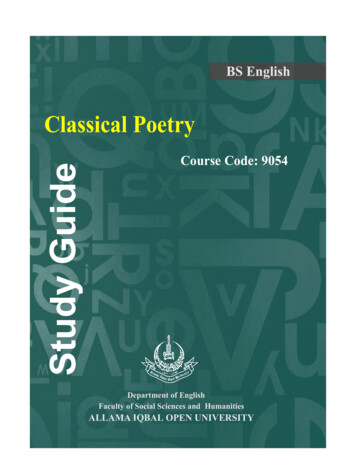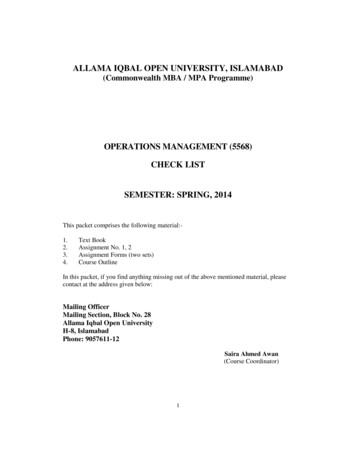
Transcription
ALLAMA IQBAL OPEN UNIVERSITY, ISLAMABAD(Commonwealth MBA / MPA Programme)OPERATIONS MANAGEMENT (5568)CHECK LISTSEMESTER: SPRING, 2014This packet comprises the following material:1.2.3.4.Text BookAssignment No. 1, 2Assignment Forms (two sets)Course OutlineIn this packet, if you find anything missing out of the above mentioned material, pleasecontact at the address given below:Mailing OfficerMailing Section, Block No. 28Allama Iqbal Open UniversityH-8, IslamabadPhone: 9057611-12Saira Ahmed Awan(Course Coordinator)1
ALLAMA IQBAL OPEN UNIVERSITY, ISLAMABAD(Commonwealth MBA / MPA Programme)WARNING1.2.PLAGIARISM OR HIRING OF GHOST WRITER(S) FOR SOLVINGTHE ASSIGNMENT(S) WILL DEBAR THE STUDENT FROM AWARDOF DEGREE/CERTIFICATE, IF FOUND AT ANY STAGE.SUBMITTING ASSIGNMENTS BORROWED OR STOLEN FROMOTHER(S) AS ONE’S OWN WILL BE PENALIZED AS DEFINED IN“AIOU PLAGIARISM POLICY”.Course: Operations Management (5568)Level: Executive MBA/MPASemester: Spring, 2014Instructions:a)b)c)All written assignment must be well organized, presented in an easy-to-read format andneat. Moreover, pay particularly close attention to grammar, spelling, punctuation andunderstandability. Communication is extremely important in this course.Documentation is likewise very important. Un-supported statements or opinionsare worth less to the reader, who desires to verify your finding. Complete andspecific documentation is mandatory. Also, your reference should be to primarysources, except in rare unusual situation.Quoting should be kept to an absolute minimum.Guidelines for Doing AssignmentsWe expect you to answer each question as per instructions in the assignment. You willfind it useful to keep the following points in mind:1.Planning: Read the assignments carefully, go through the Units on which they arebased. Make some points regarding each question and then rearrange them in alogical order.2.Organization: Be a little selective and analytical before drawing up a roughoutline of your answer. Give adequate attention to question‟s introduction andconclusion.a)The answer is logical and coherent,b)It has clear connections between sentences and paragraphs,c)The presentation is correct in your own expression and style.3.Presentation: Once you are satisfied with your answer, you can write down thefinal version for submission. It is mandatory to write all assignments neatly. If youso desire, you may underling the points you wish to emphasize. Make sure that theanswer is within the stipulated word limit.Wishing you all the best2
ASSIGNMENT No. 1(Total Marks: 100)Q.1 Suppose you have been appointed as the manager of production department inABC firm. You supervise employees and operations in production department.Customers of production department are not satisfied and are showing witchingintentions. Describe in detail that how the department under your supervision candeliver better quality services than earlier to its internal customers?(20)Q.2 Assume that a company has just committed to change from a traditional style ofmanagement to new one based on TQM. Give the details of topics which you thinknecessary to be included for: Shop floor employees Front-line supervisors Middle-level managers(20)Q.3 In a stock company, marketing department makes a sales forecast each year bydeveloping a sales force composite. Meanwhile, operations make a sales forecastbased on past experience and trends. The operation forecast usually turns out to bean increase over last year but still 20 percent less than the forecast of marketingdepartment. How should forecasting in a company be done?(20)Q.4 a)b)It is said that in information system will avail you nothing unless it is backedup by a management system. Explain.(10)Production system cannot exist as an independent system in an organization.It has to be dependent on other functional areas. Explain.(10)Q.5 Several laboratory technicians in a hospital are responsible for running the highlyautomated “Chemistry 12” blood profile test. An experienced technician wasmonitored over a two-week period (170 hours). The analyst studying the job foundthat the technician performed 412 blood profile tests, working 60 percent of thetime and idle the rest. Some idleness was due to waiting for the automatedequipment to complete the test. The technician was rated at 85 percent, but theanalyst was uncertain about this rating because of the automated equipment.Allowances are set at 10.(20)a)Determine a standard time for a standard blood profile lest.b)How could the analyst be more certain about the worker rating?3
ASSIGNMENT No. 2(Total Marks: 100)Instructions:1.2.3.4.5.6.This Assignment is a research-oriented activity. You are required to develop a termpaper and submit to the tutor for evaluation prior to the final examination. The lastdate of this assignment will be notified separately by our directorate of regionalservices and the same will be communicated to you directly as well as throughapproved study centers assigned to you.You will have to participate in the activity fully, actively and practically to beeligible to sit in the final examination of the course. Please send one copy of thisassignment to COL MBA/MPA Programme office, Block No. 11, Allama IqbalOpen University, Sector H-8, Islamabad.For the preparation of this assignment, you should first thoroughly review theconceptual framework of the topic and develop a scholarly material of the samegiving references, quotations and extracts of various scholars and experts. Thenvisit any business/commercial organization and study the relevant practical aspectsthere. Combining the theoretical and practical aspects, develop a comprehensivepaper consisting of at least 20 to 25 typed pages to be submitted to your tutor.Prepare a copy of this assignment and submit to your tutor for your evaluation.You should add any illustrative material/data/tables/analysis for effectivesubmission.If you fail to submit this assignment in the class, then you will not be able to sit inthe final examination conducted by AIOU.RequirementYou are required to select an organization of your own choice, find out the problematicsituation or dilemma relevant to your subject in that organization, which may be currentor happened in past. After highlighting the problem, design a case study upon thedilemma of that organization. Guidelines to design case study are attached herewith.Read carefully the guidelines and formulate case study strictly following these.Guidelines to Develop a Case StudyWhat a Case study is?A case study is written summary or syntheses of real-life cases based upon data andresearch. It suggests a story with a beginning, middle and end. It is a challenge with aresult or a problem with a solution. Approach to design case study is: Challenge Solution ResultCast studies indentify appropriate strategies for the resolution of dilemma of the case.Case study is a part of effective knowledge management. It is specific and easilydigestible story format which comes up with a solution. Case study is the practical4
implication of business studies. It enriches your exposure to field work and yourmanagerial and executive expertise to handle organizational issues.Business case studyTo summarize real-life business scenarios, a problem occurring in organizational setup ora dilemmatic situation, leading to operational misconduct and inefficiency inorganizations is business case study. The issue may be from any field like finance, HRM,Management, Strategic Management, Production, Marketing and General Operations etc.Case Study Layout Title page Abstract Introduction Major characters Company/organizational background Industry profile/context Dilemma of case/ Storyline/ Case Presentation Management Outcome Conclusion Discussion Exhibits Acknowledgement ReferencesTitle page:The title page will contain the full title of the case study. A title must not be vague ornon-specific because it may not attract readers‟ attention. The two most common formatsof titles are nominal and compound. A nominal title is a single phrase, for example “Acase study of hypertension which responded to spinal manipulation.” A compound titleconsists of two phrases in succession, for example “Response of hypertension to spinalmanipulation: case study” Keep in mind that title of articles average between 8 and 9words in length.Abstract:An abstract consists of a short version of the while paper. There are no headings withinthe abstract. The author simply tries to summarize the paper into a story which flowslogically.IntroductionThe introduction is where we convey case study to the reader. It is useful to begin byplacing the study in a historical or social context. If there is something especiallychallenging about the diagnosis or management of the condition that we are describing,now is our chance to bring that out. Introduction doesn‟t need to be more than a few5
paragraphs long, and the objective is to have the reader understand clearly, but in ageneral sense, why it is useful for them to be reading about this case. Avoid using jargonsspecifically in introduction. Introduction should create a dramatic interest.Major charactersIn the case there are assumed characters around whom the whole story revolves.Dilemma is made easy to understand through these characters. Select your characterswith their names and designations.Company/organizational backgroundReporting of background should be very selective. It is not the history of the whileorganization but a history that relates to the problem or decision. Avoid evaluating ormisleading descriptions. Information about the organization should shed light on theproblem.Industry profile/contextIndustry profile gives the details of the context within which the organization operateswith pressures, threats, laws, information on competitors and other external factors thatimpact the organization.Case Dilemma/ Storyline/ Presentation:This is the part of the case in which we introduce the raw data. First, describe thecomplaint that brought the situation to you. Next, introduce the important informationthat is obtained from history-taking. There is no need to include every detail – just theinformation that helped to settle on diagnosis. Also, try to present dilemma information ina narrative form – full sentences which efficiently summarize the results of questioning.The next step is to describe the results of our clinical examination. Again, we shouldwrite in an efficient narrative style, restricting ourselves to the relevant information. It isnot necessary to include every detail in our clinical notes. Also, you should describe theactual results, since not all readers will have the same understanding of what constitutes a“positive” or “negative” result. Dilemma is the main problem or the main motive to writeup a case so it should be logical, clearly narrated, well structured and very near to reality.It must not be self created or assumption based. The case must realistically grapple withthe problem and appreciate the complexity of decision making in the real world. It is alsoimportant that case does not contain holes that are manipulative and that lead readers tofeel that games are being played with them. A balance must be attained between givingenough material to make informed choice or decision, but not so much material that theanswer is given away.Management and Outcome:In this section, we should clearly describe the plan for settlement of the situation and theoutcome. It is useful for the reader to know what types of remedial actions have beentaken. Additionally, you should be as specific as possible in describing the remedialaction that was used. If some techniques have been used you are required to elaborate6
clearly those techniques. Remember that our case study may be read by people who arenot familiar with managerial techniques.ConclusionHere the problem and options for consideration are restated but the decision point is openfor students to resolve. The case should never end with a „yes‟ or „no‟ or „right‟ or„wrong‟ answer. The conclusion should create tension and suggest options for thereaders. Successful cases have no definite conclusions.DiscussionIn this section identify any questions that the case raises. It is not compulsory to provide acomplete physiological explanation for everything that is observed. We summarize thelessons learned from this case.ExhibitsIf you have used any tables, figures or photographs, they should be accompanied by asuccinct explanation. Tables, figures and photographs should be included at the end ofthe case. Exhibits are the supporting supplementary material of the data given in thewhole case study. The purpose of each exhibit should be very clear. If an exhibit has beenused in the case, it should be very simple and clear. These are used to simplify and clarifythe next of the case and to help with resolution of dilemma and the making of decision.AcknowledgementsIf someone provided assistance with the preparation of the case study, thank them briefly.It would generally be regarded as excessive and inappropriate to thank others, such asteachers or colleagues who did not directly participate in preparation of the case.ReferencesOnly use references that you have read and understood and actually used to support thecase study. Do not use more than approximately 15 references without some clearjustification. Try to avoid using textbooks as references, since it is assumed that mostreaders would already have this information. Also, do not refer to personalcommunication, since there is no way of checking this information.Types of case studyTypes on the basis of structure Open ended case studyThe case studies having no questions at the end are open ended case studies. Thesecase studies are end up with a tense situation for readers. Readers themselves drawthe questions and find solution to dilemma. Close case studies ending up with questions are close ended case studies. These arethe most common types of case studies. These are easy to find solution for readers.The questions are drawn on the basis of dilemma and storyline of case.7
Types on basis of subject matterExploratory case studyAn exploratory case study is the type of case study where the researchers or case studydesigner wants to explore some unexplored. Where considerable uncertainty exists aboutprogram operations, goals and results, the exploratory case study is designed to identifyquestions, select measurement constructs and develop measures.Program implementation case studyA program implementation case study helps discern whether implementation complieswith intent. This case study may also prove useful when concern exists aboutimplementation problems. Extensive, longitudinal reports of what has happened overtime can set a context for interpreting a finding of implementation variability.Program effects case studyProgram effects case studies can determine the impact of programs and provideinferences about reasons for success or failure. As with the program implementation casestudy, the evaluation questions usually require generalizability and for a highly diverseprogram, it may become difficult to answer the questions adequately and retain amanageable number of sites. But methodological solutions to this problem exist. Afterindentifying findings of specific interest, researchers may then implement case studies inselected sites to maximize the usefulness of the information.Company field casesThese cases are developed in cooperation with the participating company, have companyapproval and are the most common types of cases.Individual field casesThese cases focus upon specific individuals e.g. role of a woman in NGO leadership.General experience casesThese cases are written on the basis of case writer‟s knowledge, a story is invented.Generally these cases are simple. Complex cases demand a real organization.Published information casesThese cases are derived from published sources such as newspapers, research reports,journals etc. and as such, must contain extensive footnotes. It must be made clear thatsuch cases have been written up based on published sources. In these cases there is noneed for company release.There are many other types of case studies in practice. You can work any of them butyour work should be very logical and well structured. Nothing must be vague leading towastage of time and efforts.8
Important Points Write in past tense Direct quotes are written in present tense Avoid jargon Logically structured Free of grammatical errors Define technical terms if not common Avoid adjectives and adverbs Avoid ambiguities and inconsistencies Refer to actors by last name consistently Do not capitalize position titles Number all exhibits and refer to them in text Writing should be clear, concise and accessible Cases should be between 1500-3000 words in lengthImportant NoteYou are advised to structure your case study in close ended structure having questions atthe end.9
Course OutlinesOPERATIONS MANAGEMENT OUTLINE (5568)1.2.3.4.5.6.PRODUCTION AND OPERATION MANAGEMENT: AN OVERVIEW1.1Scope and significance1.2Systemic View of Operations1.3Factors of Production1.4Productive Use of Resources1.5Environmental Concerns of Operations1.6Social Concerns of Operations1.7Operations management is Multidisciplinary1.8Whither Operations Manager in IndiaPRODUCTIONS SYSTEMS: ISSUES AND ENVIRONMENT2.1Introduction Role of Production Management2.2Role of Production System2.3Production/Operations Management A System View Point2.4Production System Design2.5Productivity Improvement2.6Upcoming Issues of Production Systems2.7Production Systems and Information TechnologyTOTAL QUALITY MANAGEMENT3.1Introduction3.2TQM: A Historical Perspective3.3Quality Terminilogy3.4Understanding the Customer3.5Understanding and Improving the Process3.6Employee Involvement and Improvement3.7ISO 9000: the International Quality system StandardNEED AND IMPORTANCE OF FORECASTING4.1Introduction4.2Concept of forecast4.3General Steps in the Forecasting Process4.4Importance and Applications of Forecasts in production/Operations Management.QUALITATIVE METHODS5.1Introduction5.2Judgemental Forecasting5.3Opinion-Capture Techniques5.4Forecasting Based on Cross-Impact AnalysisQUANTITATIVE METHODS OF tion to Different Functional Areas6.4Specific Forecasting Methods10
6.56.66.7Main Classes of Quantitative ModelsForecast ErrorSelecting a Suitable Forecasting Method7.CAPACITY PLANNING7.1Introduction7.2Aspects of Capacity Planning7.3Determination of Capacity Requirements7.4Evaluation of Alternative Plant Sizes7.5Determination of Equipment Requirements8.FACILITIES PLANNING8.1What is Facility Planning8.2Need for Facility Planning8.3Facility Planning-Objectives8.4Types of Layouts8.5Product Versus Process Layout8.6Developing the Process Layout8.7Conventional Approach for Developing Process Layout8.8Conventional Approach for Developing Product Layout9.WORK SYSTEMS DESIGN9.1Introduction9.2Job Design9.3Work measurement9.4Compensation10.MANAGING INFORMATION FOR PRODUCTION SYSTEM10.1Introduction10.2The Information-Oriented Society and Corporate Activities10.3Need of the Systems10.4Cross Functional systems and Operational Planning10.5Needs of production management and Work Organizations10.6Information Needs-The Business Appraisal10.7Potential Benefits in Improving Management Information System10.8Information10.9Common Information System/Data Base10.10 Quality10.11 Development of Production-Material Information System11.AGGREGATE PRODUCTIN PLANNING11.1Introduction11.2Linking Long Term and Short Term Planning11.3The Purpose of Aggregate Plans11.4Steps in Aggregate Planning11.5Dimensions of Production Capacity11.6Managerial Importance of Aggregate Plans11
12.JUST-IN-TIME (JIT)12.1Introduction12.2Stock Points in a eristics of Just-In-Time System12.5The Just-In-Time Manufacturing Philosophy12.6Elements of Manufacturing12.7JIT Purchasing12.8The Kanban System12.9JIT Implementation in Industries13.SCHEDULING & SEQUENCING13.1Introduction13.2Situation Requiring Scheduling13.3Classifying Production Systems13.4Scheduling Mass Production System13.5Scheduling Batch Production Systems13.6Scheduling Job Production Systems13.7General Principles of Scheduling14.ISSUES IN MATERIALS MANAGEMENT14.1Introduction14.2The Concept of Materials14.3Importance of Materials14.4Need for materials Management14.5Issues in materials Management15.INDEPENDENT DEMAND INVENTORY SYSTEMS15.1Introduction15.2Basic Inventory Model15.3Model Sensitivity15.4Gradual Replacement Model15.5Basic Inventory Model With Blacklogging Allowed15.6Bulk Discount Model15.7Independent Demand Systems for Multiple products15.8Models with Uncertain Demand15.9Selective Control of Inventory Items16.DEPENDENT DEMAND INVENTORY SYSTEMS16.1Introduction16.2What is MRP?16.3Material Requirement planning (MRP)16.4MRP Versus Order-Point Systems16.5Some Important Elements of MRP16.6Manufacturing Resource Planning (MRP II)16.7MRP Computations16.8MRP Implementation16.9Some Misconception About MRP12
17.TOTAL PRODUCLTIVE MAINTENANCE (TPM)17.1Introduction17.2Motivation and Identifying Characteristics of TPM17.3Eliminating Six Big Losses17.4Chronic and Sporadic Losses17.5Autonomous Maintenance17.6TPM Promotion18.ADVANCE MANUFACTURING SYSTEM18.1Introduction18.2Manufacturing systems: Evolution & Competitativeness18.3Classification of Process Technology18.4Computer Integrated Manufacturing (CIM)18.5Computer-Aided Design (CAD)18.6Group Technology (GT)18.7Computer-Aided Process Planning (CAPP)18.8Robotics18.9Computer-Aided Process Planning (CAPP)18.10 Manufacturing Planning and Control System18.11 Flexible Manufacturing System18.12 Just-In-Time Manufacturing System (JIT)18.13 Total Quality Management Systems18.14 Advanced MRP Type Systems18.15 Optimized Production Technology (OPT)19.COMPUTERS IN OPERATIONS MANAGEMENT19.1Introduction19.2Continuous Performance Improvements19.3Computers in Demand Forecasting and Order Processing19.4Computers in Design and Drafting19.5Computers in Purchasing Outsourcing19.6Computers in Materials management19.7Computers in Operations Planning, Scheduling and Control19.8Computers in manufacturing19.9Computers in process Control and Quality Management19.10 Computer in Terotechnology and productive maintenance19.11 Computers in Automatic Assemblies19.12 Computers in Finished Product Warehouses19.13 Computers in distribution (Outbound Logistics)19.14 Future Trends in Operations Management19.15 Emerging Importance of Information Technology13
allama iqbal open university, islamabad (commonwealth mba / mpa programme) warning 1. plagiarism or hiring of ghost writer(s) for solving the assignment(s) will debar the student from award of degree/certificate, if found at any stage. 2. submitting assignments borrowed or stolen from other(s) as one's own will be penalized as defined in .

